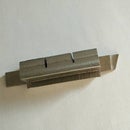Introduction: Angle Template and Gauge for Grinding Lathe Tool
Introduction
Recently I acquired a mini lathe and needed a few tool bits to start working. Ready made tool bits are expensive. Fortunately high speed steel blanks are inexpensive and are not difficult to grind.
I bought 4 pieces of 200 mm by 6 mm square HSS blanks from eBay for less than $10 postage included. The blanks are then cut into shorter lengths of 65 mm each. These come to be only some 75¢ each.
I then googled for the correct angles to grind each tool. The source of these illustrations is acknowledged.
One of the above images shows the geometry of a typical turning tool, another shows the tool profile from different planes of view.
Finally there is a table of the typical angles to grind. (Note: Front Relief is the same as End Relief.)
Grinding is simple enough. Just switch on the table grinder and dip the steel blank into a bowl of water every now and then to cool and avoid burning fingers and softening the steel. However it is difficult to eyeball and check the various angles correctly. Errors mean regrinding, wasting time and potentially losing the proper height of the cutting edge. My initial attempts were disappointing. So I made a metal template for all the significant angles, which is then used as a gauge to measure these angles as the tool bit is ground.
At first I thought of making a separate template for each angle, but then I realized that there are only four important angles of any one tool; it would be simpler to put them all on the same template. These four important angles are the end relief, the side relief, the back rake and the side rake angles. The front and side cutting edge angles are not critical and may be ground to one's preference.
Step One - Draw the Template
I took a piece of blank paper and drew the outline of a 4-sided template, each side incorporating one of the grinding angles. With the exception of the back rake which is convex, the rest are concave angles. The lengths are not important, just big enough to rest on the sides of the tool bit being ground, and small enough not to take up room to keep.
Step Two - Cut out in Metal
With a pair of heavy scissors, I cut out this pattern from a thin plated brass sheet, which I took from inside a salvaged hard disk. I also tried to cut out the pattern from the nickel memory disc from the same hard disk. I ended up with one in brass sheet and the other in nickel plate. The latter involved sawing and filing a lot but is much more robust. Either way, they serve the same purpose, and I think it might be an overkill to use anything other than a thin metal sheet to cut out the template.
Step Three - Trial and Use
The template and angle gauge was then put to use. I was able to grind the tool to close angles and profiles. The photos show the end results.
Conclusion
This simple gadget has helped me a lot. I am now going to make a new template for brass and another one for aluminium with different ground angles. I have no need to turn stainless steel or cast iron for the time being, and when I do, I shall make templates for these as well.
I hope you find this simple instructable useful.













